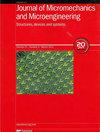用于制备单神经元培养样本的双层微阵列装置
IF 2.1
4区 工程技术
Q2 ENGINEERING, ELECTRICAL & ELECTRONIC
引用次数: 0
摘要
当单个神经元与其他神经元隔离培养时,其轴突与自身树突相连,形成一个简单、独立的网络,没有来自其他神经元的突触输入。这种培养系统能够在单个神经元水平上详细分析神经元的突触功能和形态变化,有助于阐明神经系统疾病的发病机制,并评估治疗药物的疗效。然而,以前没有一种设备技术能够同时形成多个单神经元样本,同时允许与星形胶质细胞共培养,而星形胶质细胞对于培养从其他神经元分离出来的单神经元至关重要。在这项研究中,我们提出了一种用于制备单神经元样本的新型微细胞阵列装置。该装置由用于细胞播种的上层和用于细胞培养的下层组成。每层有 16 × 16 个微孔,每个孔的底部由 1 μm 厚的氮化硅膜制成。上层孔的膜上有一个微孔,用于播种单个神经元,下层膜上有多个微孔,用于单个神经元和星形胶质细胞之间的相互作用,星形胶质细胞在膜的两侧背靠背共培养。当神经元被播种到上层孔中时,只有一个神经元穿过上层膜的微孔,落到下层膜上。我们通过改变播种孔直径和播种密度来评估单个神经元的播种效率。结果表明,当播种孔直径为 13 μm 时,无论播种密度如何,都能获得 20% 以上的产量。我们还证实,以这种方式播种的单个神经元与星形胶质细胞共培养后,可发育神经元并形成突触。这些结果证明了该装置在制备单神经元培养样本方面的实用性。本文章由计算机程序翻译,如有差异,请以英文原文为准。
Two-layered microwell-array device for preparation of single-neuron culture samples
When a single neuron is cultured in isolation from other neurons, its axon connects with its own dendrites to form a simple, independent network with no synaptic inputs from other neurons. This culture system enables detailed analysis of synaptic function and morphology change in neurites at the single-neuron level, which is useful for elucidating the pathogenesis of neurological diseases and for evaluating the efficacy of therapeutic drugs for them. However, there was previously no device technology capable of simultaneously forming multiple single-neuron samples while allowing co-culture with astrocytes, which is essential for culture of a single neuron isolated from other neurons. In this study, we propose a novel microwell-array device for preparing single-neuron samples. The device consists of an upper layer for cell seeding and a lower layer for cell culture. Each layer has 16 × 16 microwells, and the bottom of each well is made of a 1 μm thick silicon nitride membrane. The membrane of the upper well has one microhole for seeding a single neuron, and the lower membrane has multiple microholes for interaction between a single neuron and astrocytes which are co-cultured back-to-back on both sides of the membrane. When neurons are seeded into the upper well, only one of them passes through the microhole in the upper membrane and falls onto the lower membrane. We evaluated a seeding efficiency of single neurons by changing seeding hole diameter and seeding density. The results showed that the yield of more than 20% was obtained regardless of the seeding density when the seeding hole diameter was 13 μm. We also confirmed that single neurons seeded in this manner and co-cultured with astrocytes developed neurites and formed synapses. These results demonstrated the usefulness of this device for the preparation of single-neuron culture samples.
求助全文
通过发布文献求助,成功后即可免费获取论文全文。
去求助
来源期刊

Journal of Micromechanics and Microengineering
工程技术-材料科学:综合
CiteScore
4.50
自引率
4.30%
发文量
136
审稿时长
2.8 months
期刊介绍:
Journal of Micromechanics and Microengineering (JMM) primarily covers experimental work, however relevant modelling papers are considered where supported by experimental data.
The journal is focussed on all aspects of:
-nano- and micro- mechanical systems
-nano- and micro- electomechanical systems
-nano- and micro- electrical and mechatronic systems
-nano- and micro- engineering
-nano- and micro- scale science
Please note that we do not publish materials papers with no obvious application or link to nano- or micro-engineering.
Below are some examples of the topics that are included within the scope of the journal:
-MEMS and NEMS:
Including sensors, optical MEMS/NEMS, RF MEMS/NEMS, etc.
-Fabrication techniques and manufacturing:
Including micromachining, etching, lithography, deposition, patterning, self-assembly, 3d printing, inkjet printing.
-Packaging and Integration technologies.
-Materials, testing, and reliability.
-Micro- and nano-fluidics:
Including optofluidics, acoustofluidics, droplets, microreactors, organ-on-a-chip.
-Lab-on-a-chip and micro- and nano-total analysis systems.
-Biomedical systems and devices:
Including bio MEMS, biosensors, assays, organ-on-a-chip, drug delivery, cells, biointerfaces.
-Energy and power:
Including power MEMS/NEMS, energy harvesters, actuators, microbatteries.
-Electronics:
Including flexible electronics, wearable electronics, interface electronics.
-Optical systems.
-Robotics.
 求助内容:
求助内容: 应助结果提醒方式:
应助结果提醒方式:


